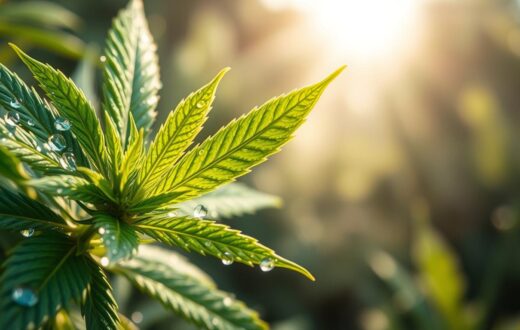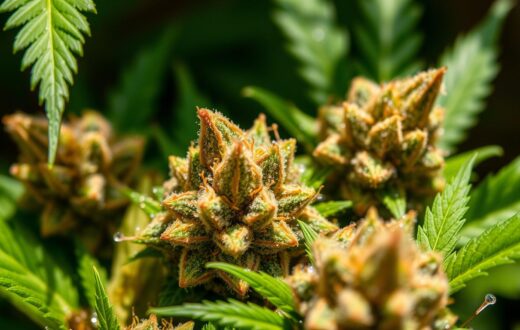The cannabis industry is growing, and we’re learning more about the plant’s compounds. Two compounds, THCA and CBN, have caught a lot of attention. They have different properties and benefits, but people often get them mixed up. So, how do you choose between THCA and CBN for your wellness routine?
We’ll explore THCA and CBN in detail. We’ll look at their chemical makeup, how they affect the body, their legal status, and their potential health benefits. By the end, you’ll know how THCA and CBN are different. This will help you make better choices about using them.
Understanding THCA: An Overview
Tetrahydrocannabinolic acid (THCA) is a key part of cannabis before it becomes Delta-9-THC. It’s found in fresh cannabis plants and doesn’t get you high until it’s changed. This makes THCA different from THC.
What Is THCA?
THCA is the acidic form of THC found in raw cannabis. It’s not psychoactive because of its carboxylic acid group. Young, fresh plants have more THCA, which turns into THC as they age or get heated.
The Chemical Structure of THCA
THCA’s structure is close to THC’s but has an extra group. This group makes it non-psychoactive. When cannabis is heated or dried, this group is lost, turning THCA into THC.
Common Uses of THCA
People use THCA for its health benefits, not for getting high. It’s used in juices or products like gummies. THCA might work through other receptors, offering relief without the high.
Exploring CBN: An Overview
The cannabis plant is famous for THC and CBD, but it has over 100 cannabinoids. Cannabinol (CBN) is one of these interesting compounds. It forms when THC oxidizes due to light, heat, or bad storage. CBN is less potent than THC but still has psychoactive effects.
What Is CBN?
CBN’s structure is similar to THC, but oxidation changes it. This process gives CBN its own benefits and effects. Unlike THC, which is common in cannabis, CBN is found in small amounts, usually less than 1%.
The Chemical Structure of CBN
When THC turns into CBN, a carbon bond breaks and an oxygen molecule is added. This change makes CBN different from THC. Scientists are studying how these changes affect CBN’s interaction with our bodies.
Benefits of CBN
Early studies show CBN might have several benefits. It could help with sleep and appetite. CBN might also protect the brain and ease muscle and joint pain. More research is needed, but CBN is seen as a promising therapeutic option.
THC: The Precursor to THCA
Tetrahydrocannabinol (THC) is a well-known psychoactive compound in cannabis plants. Many don’t know that THC comes from its precursor, THCA (Tetrahydrocannabinolic Acid). Knowing how THC and THCA relate helps us understand cannabis’s potency and effects.
The Relationship Between THC and THCA
THCA is the most common cannabinoid in raw cannabis plants. But, THCA itself isn’t psychoactive. The change from THCA to THC is what makes cannabis intoxicating. This change happens when cannabis is heated, like when it’s smoked or baked.
The Conversion Process
About 87.7% of THCA turns into THC when heated. This means not all THCA in cannabis becomes THC. Strains with up to 40% THCA can have around 87.7% of it convert to THC when heated.
The best temperature for this change is between 220-245°F (104-118°C). It’s key to know this conversion to understand cannabis’s strength and effects.
The Conversion Process: THCA to THC
In the world of cannabis, turning THCA into THC is key. This change, called decarboxylation, happens when THCA meets heat. It loses a carboxyl group and releases CO2.
How Heating Affects THCA
Decarboxylation can start with smoking, vaping, or cooking cannabis. The heat and time matter a lot. Temperatures between 220-240 degrees Fahrenheit speed up the change. But too much heat can harm THC, so finding the right balance is important.
Decarboxylation Explained
When THCA loses its carboxyl group, it turns into THC. This change unlocks THC’s psychoactive effects. It’s what gives cannabis its “high.” This change can also happen slowly, even without heat, as THCA turns to THC over time.
Knowing how THCA turns into THC is vital for cannabis users. By controlling the decarboxylation, users can choose their experience. They can go for the gentle effects of THCA or the strong effects of THC.
The Role of Cannabinoids in the Body
To grasp the role of THCA and CBN, we must explore the endocannabinoid system (ECS). The ECS is a complex network that helps keep the body in balance. It includes receptors, enzymes, and endocannabinoids, which are naturally made by our bodies.
Endocannabinoid System Basics
The ECS has two main cannabinoid receptors: CB1 and CB2. THC, the main psychoactive part of cannabis, binds strongly to CB1 receptors. This causes the “high” feeling we know. THCA, however, doesn’t bind as well to CB1 receptors. So, it doesn’t cause the same high as THC.
How THCA and CBN Interact with Receptors
CBN interacts with both CB1 and CB2 receptors but with less strength than THC. This means CBN can cause some psychoactive effects but in a milder way. Its interaction with the ECS might also offer benefits like pain relief and reducing inflammation.
Understanding how THCA, CBN, and other cannabinoids work with the ECS is key. It helps us see their potential in medicine and therapy. By studying these interactions, we learn more about how cannabis compounds affect our bodies.
Comparing the Benefits of THCA and CBN
The cannabis industry is growing fast. Researchers are finding out more about cannabinoids like THCA and CBN. These two have different ways of working and uses.
Potential Therapeutic Effects of THCA
THCA is a non-psychoactive part of cannabis. It’s like THC but doesn’t get you high. It might help with pain, brain diseases, and inflammation when eaten raw.
Potential Therapeutic Effects of CBN
CBN is known for helping you sleep. It’s also good for appetite and pain relief. Scientists think it might help with brain diseases and chronic pain too.
THCA and CBN are two different paths in cannabis research. They could help with many health issues. As we learn more, we’ll have more choices to find what works best for us.
Legal Status of THCA and CBN in the U.S.
The legal status of THCA, a non-intoxicating cannabinoid, is unclear at the federal level. The 2018 Farm Bill says hemp-derived cannabinoids like THCA are not marijuana. But, the rules for using and owning it vary by state.
Current Regulations for THCA
Under federal law, THCA is legal if the cannabis plant has less than 0.3% delta-9 THC. But, some states have stricter rules. For example, California, Colorado, and New York limit the total THC in hemp products. This could affect the legality of THCA-rich products.
Current Regulations for CBN
CBN’s legal status is also unclear at the federal level. Like THCA, its legality depends on state laws, which can be different. As laws change, the rules for THCA and CBN may shift too.
The rules around cannabis and hemp-derived cannabinoids like THCA and CBN are complex and changing fast. It’s crucial for everyone to keep up with the latest laws in their state. This way, they can follow the rules and avoid legal trouble.
Consumption Methods: How to Use THCA
There are several ways to use THCA, the non-psychoactive part of THC. One favorite is eating raw cannabis, like juicing fresh leaves. This keeps THCA in its non-intoxicating form. It lets users enjoy its health benefits without feeling high.
Raw Cannabis and THCA
Eating raw cannabis, or “juicing,” is a great way to get THCA’s benefits. Since heat changes THCA to THC, raw cannabis avoids this conversion. This way, users can get THCA’s benefits without THC’s effects.
Edibles and THCA
THCA edibles are also out there, but their effects can change. If made with heat, some THCA might turn into THC, causing a high. But, edibles made without heat can keep THCA’s benefits without the high. Knowing how the product was made is key to getting the THCA experience you want.
There’s more than just raw cannabis and edibles. The cannabis world has many THCA products, like flowers, tinctures, and topicals. These options let people enjoy THCA’s benefits without THC’s effects.
Consumption Methods: How to Use CBN
More people are interested in cannabinol (CBN) for wellness. CBN is known as the “sleepy cannabinoid.” It can be used in different ways, each with its own benefits.
CBN Oils and Tinctures
CBN oils and tinctures are a favorite for many. They are taken under the tongue for quick absorption. This method allows for precise dosing, helping you find the right amount for you.
Many find these products calming and sleep-inducing. They are a popular choice for those looking to relax or sleep better.
CBN-infused Products
CBN is also found in edibles, capsules, and topical products. Edibles like gummies and chocolates are fun and discreet. Capsules are easy to use without mess. Topical products can be applied to the skin for localized effects.
It’s important to buy from trusted brands that show lab test results. This ensures your CBN products are safe and effective. This way, you can enjoy the benefits of CBN with confidence.
Side Effects: THCA vs CBN
Understanding the side effects of cannabinoids is key to making smart choices. Let’s look at the side effects of THCA and CBN. These two compounds are getting a lot of attention in the cannabis world.
Known Side Effects of THCA
THCA is the precursor to THC and is known for its minimal side effects. Users might feel a bit of stomach discomfort or drowsiness. But these effects are usually mild and don’t happen often.
However, when THCA is converted into THC, it can cause the usual cannabis side effects. These include dry mouth, red eyes, and sometimes anxiety.
Known Side Effects of CBN
CBN is a mildly psychoactive compound that can make you feel drowsy. This can be a plus for those looking for a sleep aid. But, it might also cause dizziness and increase your appetite.
Also, both THCA and CBN can affect how certain medications work. So, it’s a good idea to talk to a doctor before using them.
The laws about THCA and CBN vary by state and federal rules. It’s important to know your local laws to avoid any trouble when buying and using these products.
THCA and CBN have their benefits, but it’s important to know their side effects. Always talk to a healthcare professional, especially if you’re taking other medications or have specific health concerns. By understanding the side effects, you can make choices that are best for your health and safety.
Research and Studies on THCA
The cannabis industry is growing fast, and so is the research on THCA (tetrahydrocannabinolic acid). Early studies show THCA might have many benefits. It could help with inflammation, protect the brain, and reduce nausea.
Current Research Findings
Researchers are looking into how THCA can help with health issues. They think it might be good for epilepsy and diseases that harm the brain. They also want to know how it works with our body’s own cannabinoids and helps with pain.
The idea of the “entourage effect” is also being studied. This means looking at how THCA works with other cannabinoids. Scientists hope to find out more about THCA’s benefits and how it can be used in treatments.
Future Research Directions
More people want to know about THCA, so researchers are excited to learn more. They plan to study THCA’s long-term effects and how it can help with different health problems. They also want to understand its place in the cannabis world.
With more places legalizing cannabis, we can expect more studies. These studies will help us understand how safe and effective THCA is. This will help in developing new treatments and give patients more options.
Research and Studies on CBN
CBN research is still in its early stages, but studies are showing great promise. It seems CBN could help with sleep, pain, and even protect the brain. These findings are exciting and could lead to new treatments.
Current Research Findings
Research suggests CBN might help people sleep better. It could also ease pain for those with fibromyalgia. Plus, it might slow down the start of ALS symptoms, as a 2005 study found.
Future Research Directions
Scientists are eager to learn more about CBN. They want to know how it affects sleep and appetite. They’re also curious about its antibacterial effects and its potential in treating glaucoma.
Hemponix is leading the way in CBN research. They’re exploring its benefits and those of other cannabinoids. With more interest in these compounds, the future of CBN research is bright.
Personal Experiences: THCA vs CBN
THCA and CBN have different effects on people. THCA fans say it makes them more alert and focused. It also helps with digestion and reduces inflammation. But, the effects of THCA can change a lot because of the varying levels in different strains.
User Testimonials on THCA
Sarah, a 35-year-old yoga instructor, loves THCA. She uses it in the morning to stay energized and focused. She also says it improves her digestion and reduces joint pain.
User Testimonials on CBN
Mark, a 42-year-old graphic designer, uses CBN for sleep. He finds it gentle and relaxing, unlike THC. He likes mixing CBN with CBD for a calming effect after a long day.
These stories show how different people react to THCA and CBN. It’s important to try different products and methods to find what works best for you.
Conclusion: Making an Informed Choice
THCA and CBN have unique properties and benefits for those who use cannabis. It’s important to understand the differences between them. This knowledge helps when deciding to use them in your wellness routine.
Summary of Key Differences
THCA is not psychoactive and is good for health when eaten raw. CBN, on the other hand, is mildly psychoactive and can help you relax. They are made differently in the cannabis plant and work differently in our bodies.
Considerations for Use
Think about what you want to achieve, the laws in your area, and any health issues before using THCA or CBN. Always talk to a doctor before adding these compounds to your routine. Make sure to buy from trusted sources for quality and safety. Knowing about THCA, CBN, and other cannabis compounds helps you choose what’s best for you.















